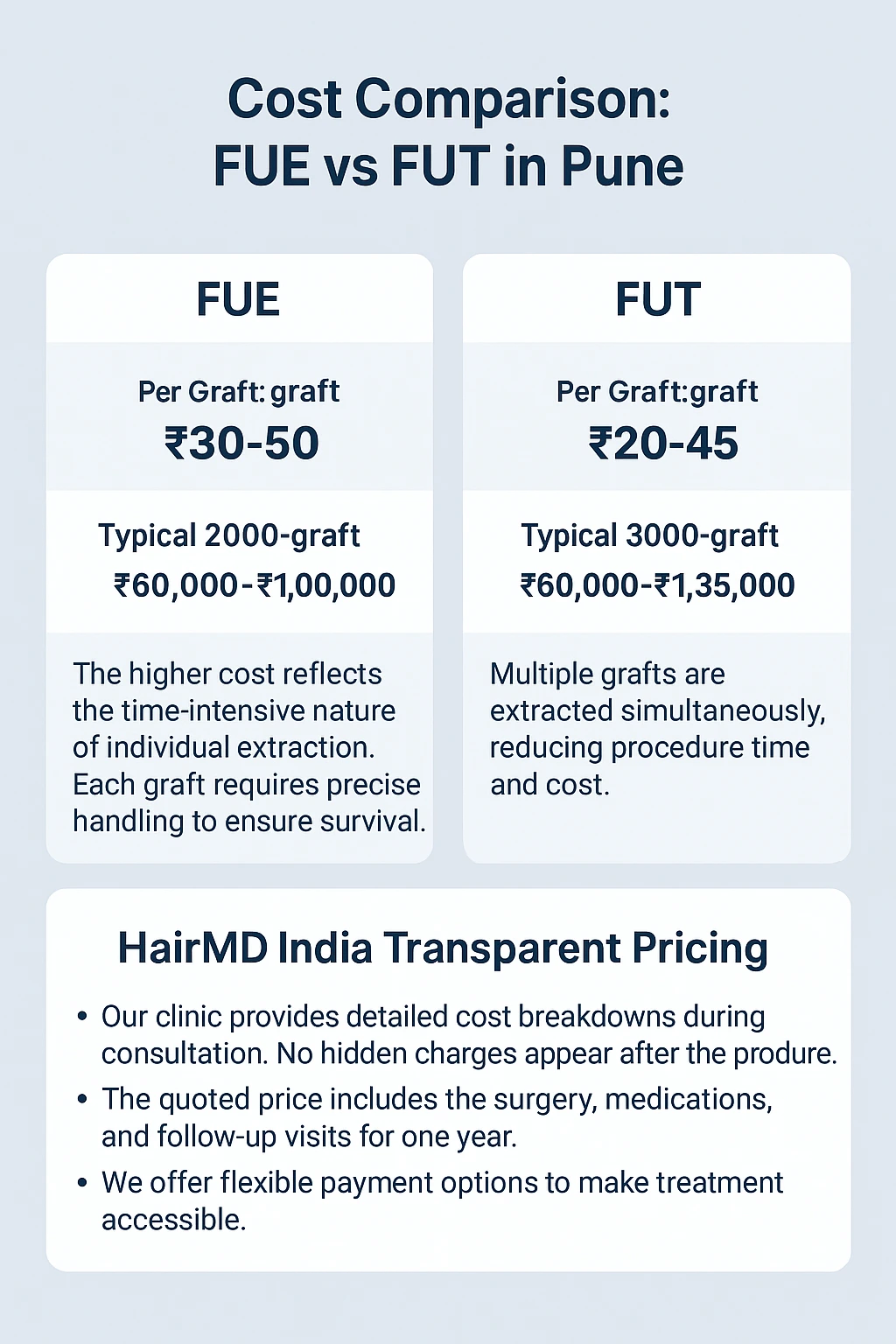
Follicular Unit Extraction (FUE) and Follicular Unit Transplantation (FUT) are two primary surgical methods for permanent hair restoration.
FUE involves extracting individual hair follicles directly from the donor area using a specialized punch tool measuring 0.8-1.0mm in diameter.
FUT removes a strip of scalp tissue from the back of the head. This strip is then dissected into individual follicular units under microscopic magnification.
Both procedures transplant healthy hair follicles from the permanent zone to areas affected by pattern baldness. The transplanted follicles retain their genetic resistance to DHT hormone, making results permanent.
FUE leaves multiple tiny circular scars while FUT creates a single linear scar.
Recovery time differs significantly between methods. FUE patients typically resume normal activities within 3-5 days. FUT patients require 10-14 days due to suture removal needs.
What’s covered in the article?
- Key Facts About FUE vs FUT at HairMD India Pune
- Key Takeaways
- FUE vs FUT: Understanding the Two Techniques
- Comparing FUE and FUT: Key Differences
- Which Method Leaves Less Scarring?
- Recovery Time and Post-Procedure Care
- Cost Comparison: FUE vs FUT in Pune
- Which Technique is Right for You?
- Success Rates and Long-Term Results
- HairMD India – External Recognition & Patient Trust
- Frequently Asked Questions
- Conclusion
Key Facts About FUE vs FUT at HairMD India Pune
- FUE extracts individual follicles using 0.8-1.0mm punch tools, leaving tiny dot scars
- FUT removes a scalp strip 1-1.5cm wide, creating a linear scar
- FUE costs ₹30-50 per graft in Pune; FUT costs ₹20-45 per graft
- FUT yields 3000-4500 grafts per session; FUE yields 2000-3000 grafts per session
- FUE recovery takes 3-5 days; FUT recovery requires 10-14 days with sutures
- HairMD India has performed 2000+ hair transplants with 98.3% success rate
- Both methods achieve permanent results with 90-95% graft survival rates
Key Takeaways
Understanding which hair transplant method suits your needs helps you make confident decisions about permanent hair restoration:
- FUE offers minimal scarring and faster recovery, ideal for those who prefer short hairstyles or lead active lifestyles
- FUT provides higher graft yield in single sessions at lower cost, perfect for extensive coverage needs or budget considerations
- Your donor hair density, baldness grade, lifestyle, and budget determine the best technique for your unique situation
FUE vs FUT: Understanding the Two Techniques
What is FUE Hair Transplant?
FUE hair transplant involves extracting individual follicular units from the donor area without removing a strip of scalp. The surgeon uses a micro-punch instrument to extract grafts one by one.
This process takes 6-8 hours for a typical 2000-graft session. Each extracted follicle is carefully preserved in a holding solution before implantation.
The donor area is shaved to 1-2mm length for precise extraction. Surgeons create tiny recipient sites in the thinning areas matching your natural hair growth pattern.
Each follicle is then implanted individually using fine forceps. The tiny extraction sites heal within 5-7 days, leaving barely visible dot scars.
Modern FUE techniques at HairMD India use precision instruments that minimize trauma to follicles. This careful handling contributes to higher graft survival rates.
Patients appreciate that FUE allows them to wear very short hairstyles without visible scarring.
What is FUT Hair Transplant?
FUT involves removing a horizontal strip of scalp from the back of the head where hair is genetically permanent.
The strip typically measures 1-1.5cm wide and 15-25cm long depending on the number of grafts needed. After strip removal, the wound edges are sutured closed using trichophytic closure technique.
A team of skilled technicians then dissects the strip under stereo-microscopic magnification. They separate individual follicular units containing 1-4 hairs each.
This microscopic dissection preserves the protective tissue around follicles, improving their survival rate after transplantation.
The dissected grafts are sorted by the number of hairs they contain. Single-hair grafts go to the hairline for natural appearance. Multi-hair grafts are placed behind for density.
This meticulous process yields more usable grafts from the same donor area compared to FUE.
The donor area scar typically measures 1-2mm wide after healing. Hair above and below the scar conceals it completely when hair length exceeds half an inch.
Modern closure techniques minimize scar width significantly.
Comparing FUE and FUT: Key Differences
Key Treatment Attributes Comparison
|
Attribute |
FUE Hair Transplant |
FUT Hair Transplant |
|
Extraction Method |
Individual follicles using micro-punch |
Strip of scalp tissue removed |
|
Procedure Duration |
6-8 hours for 2000 grafts |
4-6 hours for 3000 grafts |
|
Scarring Pattern |
Multiple tiny dot scars (<1mm) |
Single linear scar (1-2mm wide) |
|
Recovery Time |
3-5 days minimal activity restrictions |
10-14 days with suture removal |
|
Cost per Graft (Pune) |
₹30-50 |
₹20-45 |
|
Grafts per Session |
2000-3000 typical |
3000-4500 typical |
|
Donor Area Shaving |
Required for extraction area |
Not required |
|
Ideal Candidates |
Short hairstyle preference, athletes |
Large coverage needs, budget-conscious |
|
Post-Op Discomfort |
Minimal (1-2 days) |
Moderate (5-7 days) |
|
Return to Exercise |
7-10 days |
21-30 days |
Which Method Leaves Less Scarring?
FUE Scarring Pattern
FUE creates numerous tiny circular scars scattered across the donor area. Each extraction site measures less than 1mm in diameter.
These scars appear as tiny white dots that blend with the scalp once healed. When hair in the donor area is kept at 2-3mm length or longer, these scars remain virtually invisible.
Patients who prefer buzz cuts or completely shaved heads find FUE scarring acceptable. The scattered pattern prevents the formation of any linear scar.
However, with very close shaving (less than 1mm), tiny white dots may become visible under close inspection.
The healing process for FUE scars is straightforward. Initial redness fades within 7-10 days. Complete healing occurs within 2-3 weeks.
FUT Scarring Characteristics
FUT creates a single linear scar along the back of the scalp. The scar location sits in an area easily concealed by surrounding hair.
With modern trichophytic closure technique, hair actually grows through the scar line. This natural camouflage makes the scar less detectable even with shorter hairstyles.
The final scar width depends on individual healing characteristics. Most patients at HairMD India heal with scars measuring 1-2mm wide.
Scalp tension and extraction width influence scar appearance. Our surgeons carefully assess scalp laxity to minimize tension and optimize healing.
Patients planning to wear hair longer than 1.5cm find FUT scarring completely unnoticeable. The single scar is often preferable to multiple FUE dots for those keeping moderate hair length.
Recovery Time and Post-Procedure Care
FUE Recovery Timeline
Days 1-3: Mild discomfort managed with basic pain medication. Tiny scabs form at extraction sites.
Most patients return to desk work by day 3. Sleeping position requires no special precautions.
Days 4-7: Scabs begin falling naturally. Donor area appears slightly pink but not obviously surgical.
Light exercise like walking resumes. Hair washing becomes normal with gentle technique.
Weeks 2-4: All visible signs of surgery fade. Full exercise and sports activities resume by week 2.
Transplanted hairs enter resting phase and begin shedding – this is completely normal.
FUT Recovery Process
Days 1-5: Moderate discomfort along suture line requires pain medication. Bandage removed after 24-48 hours.
Sleeping requires elevated head position. Movement feels tight around donor area.
Days 6-10: Discomfort reduces significantly. Sutures may cause itching as healing progresses.
Limited physical activity continues. Hair washing requires careful attention around suture line.
Days 11-14: Suture removal appointment provides immediate relief. Scar appears pink but begins fading.
Light exercise resumes gradually.
Weeks 3-4: Return to full activities including sports. Scar continues maturing and fading.
Numbness around scar area gradually improves over several months.
Cost Comparison: FUE vs FUT in Pune
FUE costs ₹30-50 per graft at reputable Pune clinics including HairMD India. The price variation reflects surgeon experience and clinic infrastructure.
A typical 2000-graft FUE session costs ₹60,000-₹1,00,000 total.
Larger sessions of 2500-3000 grafts range from ₹75,000-₹1,50,000.
The higher cost reflects the time-intensive nature of individual extraction. Each graft requires precise handling to ensure survival.
Additional costs may include PRP therapy (₹8,000-₹15,000 per session) to enhance results.
FUT Cost Benefits
FUT pricing ranges from ₹20-45 per graft in Pune, making it 25-40% more economical than FUE.
A 3000-graft FUT procedure costs ₹60,000-₹1,35,000 total.
The lower cost reflects the efficiency of strip harvesting. Multiple grafts are extracted simultaneously, reducing procedure time and cost.
For extensive baldness requiring 4000+ grafts, FUT provides significant savings. The cost difference can exceed ₹50,000-₹75,000 for large sessions.
HairMD India Transparent Pricing
Our clinic provides detailed cost breakdowns during consultation. No hidden charges appear after the procedure.
The quoted price includes the surgery, medications, and follow-up visits for one year.
We offer flexible payment options to make treatment accessible. Many patients choose FUT specifically for its cost-effectiveness without compromising results.

Which Technique is Right for You?
Choose FUE If You:
Prefer short hairstyles: FUE’s dot scarring remains virtually invisible even with buzz cuts.
Lead an active lifestyle: Athletes and fitness enthusiasts appreciate the 3-5 day recovery. Quick return to exercise minimizes fitness disruption.
Have a tight scalp: Limited scalp laxity makes strip removal challenging. FUE works regardless of scalp tightness.
Want minimal post-op restrictions: FUE patients resume normal activities almost immediately.
Plan multiple smaller sessions: FUE allows harvesting from the same area multiple times.
Choose FUT If You:
Need maximum grafts: FUT provides 3000-4500 grafts per session for extensive coverage.
Have budget constraints: The lower cost per graft makes FUT economical for large sessions.
Don’t mind a linear scar: Patients keeping hair above 1.5cm length find the scar invisible.
Want a single procedure: FUT’s high yield often completes restoration in one session.
Have good scalp laxity: Flexible scalp allows comfortable strip removal and excellent healing.
HairMD India’s Expertise in Both Methods
Our clinic has performed over 2000 hair transplants since 1989. This includes approximately 1200 FUE and 800 FUT procedures.
Dr. Dhananjay Chavan brings 35+ years of dermatological expertise to every consultation. His assessment determines the optimal technique for your unique situation.
Dr. Sachin Pawar specializes in advanced FUE techniques. His precision has achieved 98.3% graft survival rates across 2500+ procedures.
We offer honest recommendations based on your goals, not profit margins. Many patients benefit from combining both techniques in separate sessions.
Success Rates and Long-Term Results
FUE Success Metrics
Graft survival rates for FUE at HairMD India average 95-98%. This matches international standards for excellence.
Natural hairline design remains our artistic strength. We create age-appropriate hairlines that look completely natural.
Results become visible in 3-4 months. Full growth appears by 12-14 months.
Patient satisfaction scores average 4.8/5 based on 500+ reviews.
FUT Achievement Rates
FUT demonstrates slightly higher graft survival at 96-99%. The intact tissue surrounding grafts provides extra protection.
Dense packing capability allows 40-50 follicular units per square centimeter. This creates superior density in a single session.
The ability to harvest 4000+ grafts transforms even advanced baldness. Many Grade V-VI patients achieve remarkable coverage.
Long-term studies show no difference in 5-year results between techniques.
Permanent Results from Both Methods
Transplanted hair lasts a lifetime because it retains donor area characteristics. The occipital region resists DHT hormone permanently.
Both FUE and FUT hair grows normally requiring regular cutting. Patients can style, color, and treat transplanted hair like natural hair.
Annual touch-ups are rarely needed. Most patients achieve their desired density in 1-2 sessions maximum.
HairMD India – External Recognition & Patient Trust
Featured on Practo: Listed among Pune’s premier hair restoration clinics with 4.4/5 rating from 1,500+ verified patient reviews.
Professional Recognition on LinkedIn: Established center documenting 7.2 million FUE grafts planted across 2,000+ successful surgeries since 1989.
Verified on Justdial: Dr. Dhananjay Chavan rated 4.4/5 with documented 37 years of specialized dermatology and hair restoration experience.
Industry Acknowledgment: Featured in “Top 10 Hair Transplant Clinics in Pune” by multiple healthcare platforms for consistent excellence.
YouTube Educational Authority: 670K+ subscribers trust our hair restoration education content with 100M+ total views.
Frequently Asked Questions
Is FUE better than FUT?
Neither method is universally “better” – the optimal choice depends on your individual needs.
FUE offers minimal scarring and faster recovery. This makes it ideal for those wanting short hairstyles or quick return to activities.
FUT provides more grafts per session at lower cost. It’s perfect for extensive baldness or budget constraints.
At HairMD India, our surgeons assess your specific situation during consultation to recommend the most suitable approach. Many patients qualify for both methods, so the decision comes down to your priorities regarding scarring, recovery time, and budget.
Can I get FUE if I have limited donor hair?
FUE can work with limited donor supply, but expectations must be realistic. Our surgeons calculate your total available donor grafts during assessment.
If scalp supply is insufficient, FUE can extract hair from beard, chest, or body areas. This is called Body Hair Transplant or BHT.
However, body hair has different characteristics than scalp hair. It’s typically thinner and may not grow as long.
For severely limited donor areas, FUT might actually be preferable. It extracts more grafts from a smaller donor zone efficiently.
Consultation with Dr. Dhananjay Chavan or Dr. Sachin Pawar includes detailed donor assessment to determine feasibility.
Will my FUT scar be visible?
A FUT scar is visible only if you keep your hair very short (less than 6mm length). With hair longer than 1.5cm, the scar remains hidden under surrounding hair.
HairMD India uses trichophytic closure technique. This allows hair to actually grow through the scar line, further concealing it.
Scar width depends on your scalp tension and healing characteristics. Most patients heal with 1-2mm fine line scars.
During consultation, we assess your scalp laxity to predict healing outcomes. If you’re concerned about scarring but need high graft numbers, consider FUE with multiple sessions as an alternative.
How many grafts can I get with each method in one session?
FUE typically provides 2000-3000 grafts per session at HairMD India. Extracting more becomes impractical due to procedure length and donor area depletion concerns.
FUT can yield 3000-4500 grafts in a single session. Strip removal is more efficient for large numbers.
The exact number depends on your donor density, scalp laxity, and the surgeon’s assessment.
For reference, 2500 grafts can cover a receding hairline and frontal area. Grade IV-V baldness usually requires 3500-4500 grafts for adequate coverage.
Can I combine FUE and FUT procedures?
Yes, combining both methods is an excellent strategy for maximum graft yield. Many HairMD patients choose this approach.
Typically, FUT is performed first to harvest maximum grafts efficiently. After healing, FUE can extract additional grafts from the same donor area.
This combination can yield 5000-6000 total grafts. It’s ideal for advanced baldness requiring maximum coverage.
The FUT scar can even be revised during FUE. We extract hair from scar edges to make it less visible.
Dr. Chavan and Dr. Pawar specialize in combination approaches for challenging cases.
Which method is less painful?
FUE generally causes less post-operative discomfort. Patients rate pain as 2-3/10 with basic pain medication sufficient.
The tiny extraction sites cause minimal trauma. Most patients need pain medication for only 1-2 days.
FUT involves moderate discomfort for 5-7 days. Patients rate it 4-5/10, manageable with prescribed medication.
The suture line creates tension and tightness. This resolves significantly after suture removal at day 10-14.
Both procedures use local anesthesia during surgery. Patients feel no pain during the actual procedure, only pressure sensations.
How long before I see final results?
Initial growth begins at 3-4 months for both FUE and FUT. Fine, thin hairs emerge from transplanted follicles.
By 6 months, approximately 50-60% of transplanted hair is visible. The hair gradually thickens and lengthens.
At 9 months, about 80% of results are apparent. Hair texture continues improving.
Final results appear at 12-14 months. Some patients see continued improvement up to 18 months.
The timeline is identical for both techniques. Patience during the growth phase is essential for both methods.
Does HairMD offer both FUE and FUT?
Yes, HairMD India specializes in both techniques with equal expertise. We’ve performed over 1200 FUE and 800 FUT procedures.
Our surgeons train continuously in the latest advancements for both methods. We invest in premium equipment for optimal results.
During consultation, we present both options without bias. The recommendation depends solely on your best interests.
We also offer combination procedures and repair work. Many patients come to us for corrective surgery from other clinics.
Our transparent approach includes showing actual patient results for both techniques during consultation.
Do You Know?
Nearly 250 Patients Visit HairMD
Everyday For Various Hair Concerns?
(Your journey to healthier and fuller hair starts here!)
Meet Our Dermatologists
Conclusion
Both FUE and FUT deliver permanent, natural-looking hair restoration when performed by experienced surgeons. Your choice depends on individual priorities rather than one method being superior.
Choose FUE for:
- Minimal scarring with short hairstyle options
- Faster 3-5 day recovery
- Active lifestyle compatibility
Choose FUT for:
- Maximum grafts in single session
- Cost-effective coverage for extensive baldness
- Single procedure convenience
HairMD India’s 35+ years of experience ensures excellent results with either technique. Our personalized consultation helps determine your optimal approach.
Ready to explore your hair restoration options? Contact HairMD India at +91-9584584111 to schedule your consultation with Dr. Dhananjay Chavan or Dr. Sachin Pawar at our Pune locations.
Further Reading
Relation Between Masturbation and Hair Loss
Is there a relation between masturbation & hair loss? Uncover truth with our detailed analysis, separating fact from fiction to provide clarity on this common concern.
Biotin-Rich Foods for Natural Hair Growth
Know the best foods rich in biotin to help your hair to grow naturally stronger and healthier by experts from HairMD, Pune
The Advanced Technologies Used for Hair Transplant at HairMD Pune
Restore your hair at HairMD Pune with advanced, FDA-approved transplant and regenerative therapies. 98.5% success, 6 locations, expert care.
Hair Transplant Cost in Pune vs Mumbai – Which Is Better Value?
Compare hair transplant costs in Pune vs Mumbai. Learn how Pune offers 20–30% lower prices without compromising quality. Discover expert insights from HairMD India.
Have thoughts? Please let us know
We are committed not only to treating you, but also educating you.










